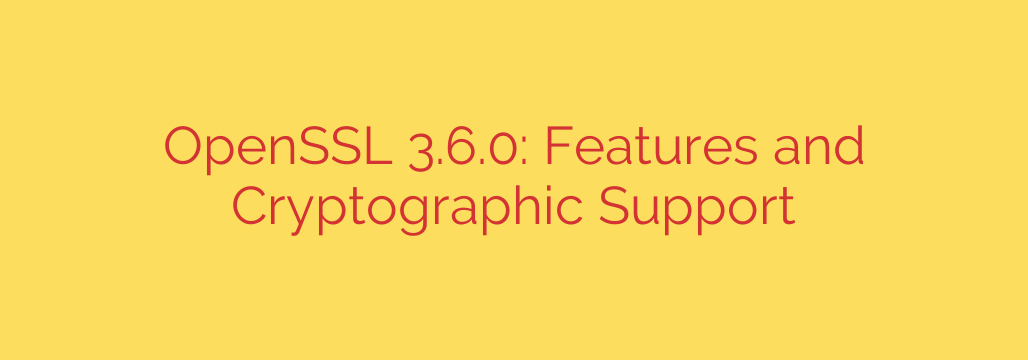
Understanding OpenSSL 3.6.0: Enhanced Cryptography and New Features Explained
OpenSSL is a foundational pillar of modern digital security. As the open-source cryptographic library that powers countless servers, applications, and devices, its updates are critical for maintaining a secure and private internet. The release of OpenSSL 3.6.0 marks another important step forward, introducing new features, expanded algorithm support, and key improvements for developers and security professionals.
This update reinforces the library’s commitment to modern cryptographic standards while providing the tools necessary to build robust and secure systems. Let’s explore the most significant changes and what they mean for the future of digital security.
Key Features and Enhancements in OpenSSL 3.6.0
While not a Long-Term Support (LTS) release, version 3.6.0 delivers valuable enhancements that address evolving security needs and improve the developer experience.
Expanded Cryptographic Algorithm Support
One of the core functions of OpenSSL is providing a comprehensive suite of cryptographic algorithms. This version expands that support, ensuring compatibility with a wider range of systems and standards. Key additions include:
- New Elliptic Curves: Support has been added for the brainpoolP160r1 and brainpoolP160t1 curves in the default provider. These curves are used in various European and German government standards, enhancing interoperability for specific applications.
- KDF Algorithm Improvements: The Key Derivation Functions (KDFs) have been updated, offering more flexibility and control over how cryptographic keys are generated and managed from a master secret.
These additions ensure that developers have access to the specific cryptographic primitives required by certain industry or government regulations, without needing to rely on third-party libraries.
New API Functions for Enhanced Control
For developers building secure applications, API enhancements are crucial. OpenSSL 3.6.0 introduces several new functions that provide more granular control over security operations. A notable addition is the EVP_PKEY_CTX_set_security_level() function.
This function allows developers to programmatically set the security level for specific operations, such as signature generation or encryption. For example, a developer can enforce a 128-bit security level, ensuring that only cryptographic algorithms meeting that strength (like AES-128 or specific elliptic curves) are used for a particular task. This helps prevent the accidental use of weaker, legacy algorithms within an application.
Improved Build System and Platform Support
Under the hood, OpenSSL 3.6.0 includes various improvements to its build system and expands its compatibility with different platforms and compilers. This work ensures that OpenSSL can be reliably compiled and deployed across a diverse technological landscape, from massive cloud servers to embedded devices. Streamlining the build process makes it easier for system administrators to deploy updates and maintain a consistent security posture.
Practical Security Advice: What This Means for You
Staying current with cryptographic libraries is not just about gaining new features; it’s a critical security practice. Here are actionable steps to take in light of this release.
- Audit Your Dependencies: If you are a developer or system administrator, your first step should be to identify all applications and systems that rely on OpenSSL. Understand which version you are currently running and whether an upgrade path is necessary.
- Plan for Future Upgrades: While 3.6.0 is an important release, it is not an LTS version. The current LTS release is OpenSSL 3.0.x. Teams should have a clear strategy for migrating to a supported LTS version to ensure they receive long-term security patches.
- Leverage Modern Security Features: When building or configuring applications, prioritize strong cipher suites and modern cryptographic protocols. Avoid using deprecated or known-weak algorithms. The new API functions in 3.6.0 can help enforce these best practices at the code level.
- Test Thoroughly Before Deployment: Before rolling out any OpenSSL update in a production environment, conduct thorough testing in a staging environment. Ensure that all applications continue to function correctly, as changes in cryptographic libraries can sometimes cause unexpected compatibility issues.
The Path Forward
The release of OpenSSL 3.6.0 is a testament to the ongoing effort required to secure our digital world. By incorporating stronger algorithms, providing developers with better tools, and improving overall stability, this update serves as a vital link in the chain of trust that underpins online communication. Keeping systems patched and leveraging modern cryptographic standards is not just a recommendation—it is an essential responsibility for anyone managing digital infrastructure.
Source: https://www.helpnetsecurity.com/2025/10/02/openssl-3-6-0-released-new-features/








